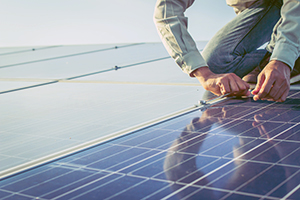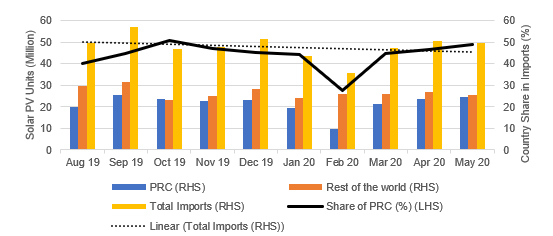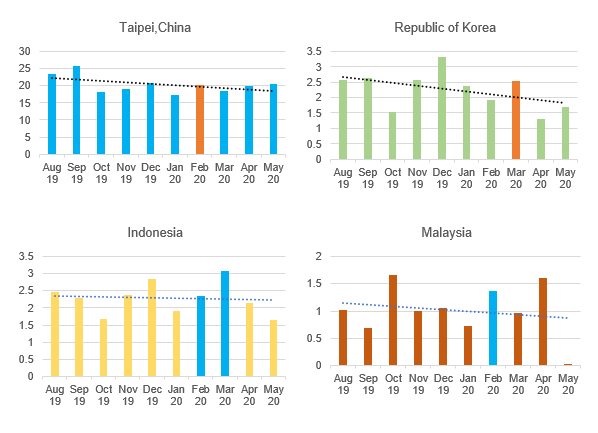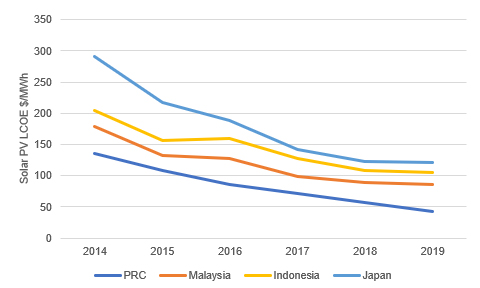
Experts are increasingly acknowledging the vulnerability of the global solar photovoltaic (PV) value chain due to the concentration of manufacturing capacity in only a few countries, such as the People’s Republic of China (PRC) (Zhai 2020). In Japan, although solar power comprised only 7% of the country’s total power generation in 2018, it contributed to one-third of power from renewable sources. Given this high share of solar power in renewable energy sources, disruption in the availability of solar PV may have adverse consequences on the sustainability of renewable energy power generation. These facts and Japan’s high dependence on imports for its solar PV module supply highlight the importance of the diversification of the sources of supply. This diversification may require higher transaction costs but will certainly ensure better protection against disruptions, including pandemics.
Japan’s imports of solar PV
Mishra and Azhgaliyeva (2020) analyze the trend in monthly imports of solar panels to Japan for the period August 2019–May 2020. Due to limited data for evaluating the impact of the coronavirus disease (COVID-19) on energy trade in Japan, the study uses data on imports of solar PV from Trade Statistics of Japan by Japan’s Ministry of Finance. The preliminary findings show that imports of solar PV modules significantly decreased in February 2020 during the initial COVID-19 outbreak (Figure 1) (Mishra and Azhgaliyeva 2020). During March–May 2020, imports started to pick up significantly and slowly began returning to normal.
Figure 1: Imports of solar PV modules

Source: Authors’ elaboration using data from Trade Statistics of Japan, Ministry of Finance of Japan.
In the PRC—the world’s largest producer of solar cell modules and also a major exporter of solar PV modules to Japan, accounting for 41% of its total imports in 2019—there was a decline in solar PV plant operations following the extension of the 2020 Lunar New Year holiday period due to the outbreak of COVID-19. By the end of February 2020, the plant-operating ratios in the PRC had generally recovered, and production and distribution were almost normalized by April (Kaizuka 2020). This shortage of supply was a major cause of the import decline in Japan in February 2020. However, during the same period, there was an increase in imports of solar PV modules from other major exporting partners, such as Taipei,China; the Republic of Korea; Indonesia; and Malaysia (Figure 2). The levelised cost of energy for solar PV, which reflects the average cost of energy over the lifetime of the technology, is the lowest in the PRC, followed by Malaysia, Indonesia, and Japan (Figure 3). After March 2020, there were declines in imports from those countries depending on their lockdown or partial lockdown periods. This evidence suggests that the diversification of trading partner countries is essential for ensuring a consistent supply of solar PV modules.
Figure 2: Imports of solar PV modules from other major trade partners
(million units)

Source: Authors’ elaboration using data from Trade Statistics of Japan, Ministry of Finance of Japan.
Figure 3: Levelized cost of energy (LCOE) of solar PV

Source: Authors’ elaboration using data from Bloomberg Intelligence, Bloomberg terminal.
Policy recommendations
Tackling sustainable energy issues together with the COVID-19 pandemic crisis can strengthen resilience through positive environmental impacts. This requires a coherent policy formulation that minimizes the effects of the pandemic in the short run and supports energy sustainability in the long run.
Japan was the leader in the solar panel industry until the latter half of the 2000s, when it was overtaken by the PRC (Ohira 2017). Japanese customers are still dependent on domestic manufacturers for their housing needs for solar PV modules. As every crisis also brings with it new opportunities, the current crisis can be considered as an opportunity to make domestic manufacturing more cost-competitive and reduce dependency on one import source. This kind of diversification would be helpful in reducing risk and making the sustainable energy supply chain more resilient to shocks.
In a similar vein, the current fiscal stimulus package offered by the Japanese government to mitigate disruptions in the supply chain also includes providing $2.2 billion to manufacturers to shift production from the PRC to Southeast Asian countries (Reynolds and Urabe 2020). As there is a dependence on a few large suppliers for renewable energy sources, more specific plans are needed for diversification, especially focusing on the solar energy sector. As diversification of the renewable energy source supply chain would be gradual and a long-term process, achieving cost-competitiveness would require making use of comparative advantage, such as in low labor costs and access to materials. The transfer of technology and technical know-how to developing countries through the formation of regional trade cooperation would be helpful in expediting the process.
Conclusion
To ensure a sustainable energy supply, we recommend the domestic production of solar PV modules and greater diversity in energy and energy technology trade partners through regional cooperation Regional trade cooperation, such as trade liberalization, may reduce the cost of domestic solar PV module production due to faster and cheaper access to materials and also help to diversify trading partners for importing solar PV modules. The strengthening of regional cooperation has the potential to remove multiple constraints on the development of renewable energy sources. These constraints include (i) limited investment capacity, (ii) regulations and unattractive market conditions, (iii) insufficient interconnection capacities and (iv) significant needs in innovation, technology transfer, and skills development (UNECA 2013). As such, the formation and strengthening of regional cooperation can be mutually beneficial for both importing as well as exporting counties.
_____
References:
Kaizuka, I. 2020. Impact of the New Coronavirus Disease (COVID-19) on Global PV Market. Renewable Energy Institute.
Mishra, R., and D. Azhgaliyeva. 2020. Going ‘Green’ During the COVID-19 Crisis. IAEE Energy Forum (Special Issue, May 2020), International Association for Energy Economics.
Ohira, Y. 2017. China’s Solar Panel Makers Turn up the Heat in Japan: Big players Muscle in with Low Prices as US Market Restrictions Loom. Nikkei Asian Review, 10 November.
Reynolds, I., and E. Urabe. 2020. Japan to Fund Firms to Shift Production Out of China. Bloomberg, 8 April.
UNECA. 2013. Regional Cooperation Policy for the Development of Renewable Energy in North Africa.
Zhai, Y. 2020. The Pandemic May Break Value Chains, but Solar Energy Can Still Shine. Asian Development Blog.








Comments are closed.